QST Contract Beamlines
BL11XU: QST Quantum Dynamics 1 beamline
| Persons in charge |
Primary Dr. Takaya Mitsui, QST Magnetism Research Group Senior Principal Researcher Secondary Dr. Kenji Ishii, QST Advanced Spectroscopy Research Group GL |
| Nearest entrance and exit | B1 in SPring-8 storage ring building |
| SR source | In-vacuum undulator |
| SR energy | 6–70 keV |
| Monochromator | A double-crystal monochromator with liquid nitrogen cooling |
| Characteristics | A multi-crystal exchange system makes it possible to exchange two kinds of dispersive crystals, Si (111) and Si (311), in a vacuum. |
| Research fields | Nuclear resonance scattering experiments, inelastic X-ray scattering experiments, in situ observations of crystal growth |
| Apparatuses |
Synchrotron radiation Mössbauer spectroscopy station (QST) Resonant inelastic X-ray scattering spectroscopy station (QST) Surface X-ray diffractometer (QST) |
BL14B1: QST Quantum Dynamics 2 Beamline
| Persons in charge |
Primary Dr. Hiroyuki Saito, QST Hydrogen Materials Research Group GL Secondary Dr. Ayumi Shiro, QST Hydrogen Materials Research Group Senior Researcher |
| Nearest entrance and exit | B2 in SPring-8 storage ring building |
| SR source | A bending magnet |
| SR energy | 5–90 keV (monochromatic), 5–150 keV (white) |
| Monochromator | Double-crystal monochromator with water cooling and a crystal bender |
| Characteristics | Synchrotron radiation with a continuous spectrum (white X-rays) is available by removing the dispersive crystals from the X-ray axis. The monochromatic X-ray is used in ordinal XAFS experiments and angle-dispersive diffraction experiments. The white X-ray is convenient to energy-dispersive XAFS (DXAFS) measurements for in-situ observation of local structure variations and energy-dispersive diffraction measurements in high-pressure experiments. A bending mirror or a dispersive crystal provides a focused high-intensity monochromatic X-rays. Insertion of a mirror helps reduce higher harmonics from white X-rays and is effective in DXAFS experiments. |
| Research fields | High-pressure science, physical properties influencing the crystal structure, surface science, in-situ observations of catalytic reactions, structure analysis by XAFS |
| Apparatuses |
High-pressure and high-temperature apparatus (QST) Energy-dispersive XAFS measuring station (JAEA) |
QST Apparatuses
Synchrotron Radiation Mössbauer Spectroscopy Station (BL11XU/QST)
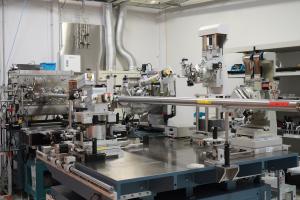
- A nuclear resonance spectrometer that generates ultra-high-brilliant 14.4 keV Mössbauer γ-rays from synchrotron radiation enables local analysis of magnetic interactions, electronic states, and spin configurations of functional substances and materials.
- Focused Mössbauer γ-rays allow microscopic analysis of tiny parts of a sample and study of material states under ultrahigh pressure, whose sample space is limited to around 10 μm.
- Crystal site-selective magnetic structure analysis using a diffraction method and local magnetism survey of magnetic thin film using grazing incidenceMössbauer spectroscopy can be used.
- Ni is also observable. Consultation is required for other elements.
Typical application: Chemical analysis of earth-related materials under ultrahigh pressure, study of local magnetism on surface/interface of functional magnetic thin films etc.
Resonant Inelastic X-ray Scattering Spectroscopy Station (BL11XU/QST)
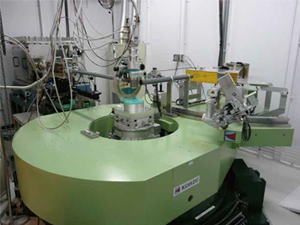
- This device enables X-ray spectroscopy experiments with an energy resolution of about 0.1 eV for both incident X-rays and scattered (emitted) X-rays.
- In-situ observation of electronic states of catalytic materials is possible by high-energy resolution fluorescence detected X-ray absorption spectroscopy (HERFD-XAS) and X-ray emission spectroscopy (XES).
- Using a resonant inelastic X-ray scattering (RIXS) technique, momentum-dependent electronic excitations can be measured in a four-circle geometry.
- Sample temperatures of 10–800 K are available.
Typical applications: Observation of charge, spin, and orbital excitations in transition-metal compounds, Operando analysis of electronic states in catalysts and electrodes.
Surface X-ray Diffractometer (BL11XU/QST)
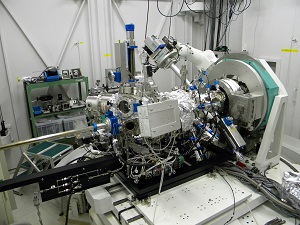
- This device enables real-time and in-situ observation using X-ray diffraction, making it ideal for studying growth processes of semiconductor heterostructures, multilayer films, quantum dots, and nanowires.
- The growth of semiconductor nitrides such as GaN and InN is possible by using molecular beam epitaxy (MBE) with RF generated atomic nitrogens (RF-MBE).
- This supports the creation of high-quality electronic materials.
Typical application: Real-time analysis of growth processes for semiconductor quantum dots and semiconductor multilayer films.
“Virtual Lab Tour” (YouTube in Japanese)
High-pressure and High-temperature Apparatus (BL14B1/QST)
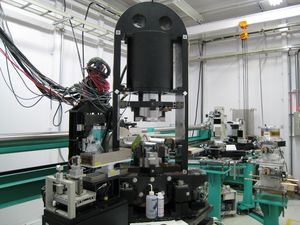
- This device allows observation of changes in material state and reaction progress under high pressure and high temperature using energy-dispersive X-ray diffraction with white X-rays.
- This device can generate pressures up to 100,000 atmospheres and temperatures up to around 2000°C.
- This supports high-temperature and high-pressure synthesis of materials.
- It can also generate a high-pressure and high-temperature hydrogen atmosphere of up to 100,000 atmospheres and around 1000°C, which is utilized for exploring new hydrogen storage materials through in-situ observation of metal hydrogenation reactions under high-temperature and high-pressure conditions.
Typical application: In-situ observation of formation processes of metal hydrides under high pressure.
Diffractometer for Rapid-acquisition Pair Distribution Function Measurements
(BL22XU/QST X-ray diffractometer for diamond anvil-cell)
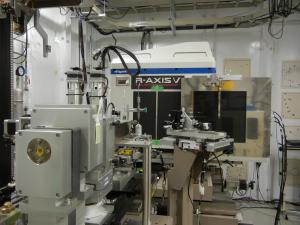
- This device rapidly performs the measurements necessary for deriving the atomic pair distribution function (PDF), which allows evaluation of deviations from the average structure and local structure of crystals.
- Using high-energy X-rays up to 70 keV, this device can perform X-ray total scattering measurements with a maximum Q of 27 Å-1, allowing derivation of PDF distance correlations up to about 100 Å.
- This device allows low-temperature measurements using an open-flow cryogenic gas cooler, as well in-situ observation under hydrogen and nitrogen gas atmospheres of less than 1 MPa.
- Measurements can be performed in several seconds to several minutes per measurement point.
Typical applications: Hydrogen absorbing materials, negative thermal expansion materials.
Diffractometer for Coherent X-ray Diffraction Imaging
(BL22XU/QST General purpose multi-axial X-ray diffractometer)
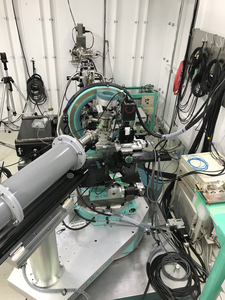
- "This device allows non-destructive 3D visualization of the internal structures (such as strain distribution, defects, voids, and domains) of nanocrystals (with grain sizes ranging from tens of nanometers to several micrometers) that are difficult to observe with electron microscopy, as well as their shapes.
- This method uses coherent X-ray diffraction imaging based on Bragg reflections in the hard X-ray region.
- This supports evaluations of nano-size materials.
- Please consult for the sample environment control. Sample temperature is controllable from a room temperature to around 1100℃.
Typical applications: Three-dimensional visualization of 100–500 nm barium titanate nanocrystals. Three-dimensional visualization of 40 nm palladium nanocrystals.
